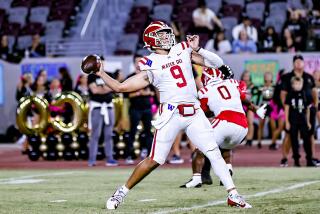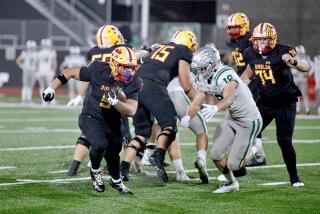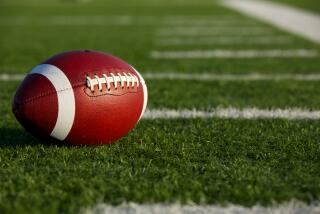Southern California Prepares for a Test
- Share via
There is more at stake this weekend at the Pond of Anaheim than championship rings and basketball memories. Southern California is playing host to the state high school basketball championships for the first time since 1983 and only the second time ever.
At the Sports Arena in ‘83, there were boys’ and girls’ championship games in only three divisions and they drew poorly.
“Basically, nobody attended,” CIF Southern Section Commissioner Dean Crowley said.
Added state basketball advisory committee member Ray Bell: “It was a financial disaster.”
In February 1996, the California Interscholastic Federation executive council figures it took a big risk when it approved a plan to alternate the state basketball tournament and the state track and field championships between Northern and Southern California for at least two years.
The basketball tournament has been played before large crowds at the Oakland Coliseum Arena and Sacramento’s Arco Arena, and the track and field finals have been equally successful at Cerritos College.
“The CIF would like fans across the state to be able to see both championships,” CIF spokesman Jim Duel said. “It seemed unfair that northern track teams always had to travel south. This was a way to balance it.”
But if Southern California is going to continue as a site for the state tournament [the CIF has an option to return it to the Pond in 1999], it will have to prove it can generate a crowd.
Average attendance the last seven years has been 20,234 for the two-day, 10-game event, with a high of 22,613 at Arco Arena in 1992 and a low of 18,204 at Oakland in 1994. State officials probably will reconsider alternating basketball and track if attendance falls off sharply this weekend.
“Basketball pays for a lot of what we lose to put on track and [girls’] volleyball [state championships],” Bell said. “What would be considered a successful tournament is hard to say. If [the revenues] are within what was projected, I’m sure the state would be pleased. If they fall well below, then they would have to take a look at it.”
The CIF expects the regional and state championship tournaments to generate about $220,000 of its $1.165-million operating budget.
The Pond got a trial run last Saturday as the site for six Southern California Regional finals, including the boys’ Division I showdown between Crenshaw and Santa Ana Mater Dei. Attendance was 10,918.
The total was lower than expected. Dave Zirkle, athletic director at Orange High and a member of the state basketball advisory committee, attributed the disappointing figure in part to Crenshaw having both its boys’ and girls’ teams in the finals.
“That cost us about 25% of the crowd we could have had if there had been a fourth school [in the Division I games] selling tickets and bringing people to the Pond,” Zirkle said. “But I think we can get 15,000 for the 10 state tournament games.”
Would that be enough?
Margaret Davis, CIF associate executive director, wouldn’t speculate. She hopes the state executive council doesn’t judge everything by crowd size.
“To me, success is not a budgetary question,” Davis said. “It’s having a fabulous venue, treating the kids and schools in an appropriate fashion and giving the fans an exciting and well-managed, accessible state championship. That’s what we’ve done.”
*
The CIF began receiving inquiries from players, parents, coaches, administrators and Pond officials about bringing the tournament south four years ago.
Davis said she was receptive to the idea but didn’t know if she and Southern Section officials could persuade the state executive council to loosen the North’s hold on the tournament.
Her cause was helped by the opening of the Pond in June 1993. The Pond has had the Southern Section and Southern California Regional championships the last three years. Attendance at the regional tournament has declined each year, from 16,906 in 1995 to 12,178 last year and to 10,918 last weekend.
Brad Mayne, the Pond’s general manager, said the high school basketball events were among the first contracts negotiated by the arena’s management. He said Pond officials were eager to host the state tournament, but understood the CIF had a multiyear contract with the Oakland Arena. The first available dates were in March 1997, if the state council would agree to a change of venue.
“We held onto those dates for them,” Mayne said. “There were a couple of offers during that time, but Margaret asked us to hang on, so we did.”
An added boost for Southern California’s hopes was the planned renovation of the Oakland Arena, making it unavailable.
The executive council’s reasoning in deciding to alternate championship sites was twofold:
--The CIF does not consider track and field a team sport--an individual can qualify for a finals event--and does not reimburse athletes for their travel expenses. The track championships were always in Southern California, meaning Northern California athletes had higher expenses to compete.
Those finals, at Cerritos College since 1988, will be in Sacramento this spring.
--The Pond gives Southern California the kind of venue the state executive council wanted: A state-of-the-art facility that can attract people to the event, regardless of who is playing.
“With the Pond . . . there seems to be a solid fan base for the [section] regionals, even though it’s tailed a bit from its first year,” Bell said. “Now we hope it continues by trying the state tournament there.”
*
After staging boys’ state championship games at various locations--mostly school sites--in 1916 and 1917 and again from 1920-28, the state championship went on hiatus.
The CIF resumed games, adding girls’ divisions, in 1981 in Oakland. The Southern Section, which did not participate in 1981 or ‘85, eventually became a permanent participant in the tournament. The Southern is by far the largest of 10 sections in California, with 494 schools. The other nine range from the Oakland Section, with six schools, to the Sac-Joaquin Section with 139.
“We in the Southern Section realized that as a member of CIF, we had to support CIF events,” said Ray Plutko, former Southern Section commissioner.
Plutko, principal at Temple City High, blamed poor attendance at the Sports Arena finals in 1983 on bad timing.
“It was a different climate in the 1980s,” said Plutko, the section commissioner from 1980-86. “For many years the Southern Section voted not to participate in the tournament; at that time, the Southern Section had as many high schools as the rest of the state, and felt its own playoffs were the equivalent of a state tournament.
“I wouldn’t call it arrogance. . . . Before basketball, the only other state tournament was wrestling. So the concept, plus dealing with the overall size of the state, was something new to the south.”
The state finals returned to Oakland from 1984-87.
In 1988 and ‘89, the top three boys’ and girls’ divisions championship games were played in Oakland, and divisions IV and V were played at various sites, including in Southern California.
Since then, all games have been played at the Oakland Coliseum Arena or Arco Arena.
*
Locations aside, the format of the state tournament is what bothers many coaches and fans.
Unlike most states, California doesn’t seed teams in its tournament. Schools qualify from one of 10 sections and are placed in divisions based on enrollment. Six sections compete in the Northern Regional and four in the Southern Regional.
Winners from each regional play for the state title.
In many cases, a regional final is often a better matchup than a state final. The size of California and travel costs have kept CIF officials from seriously considering any other format.
“Certainly we put more emphasis on our section final than the state tournament,” said Crenshaw girls’ Coach Greg Cobbs, whose team plays Berkeley in the Division I final Saturday night. “I think there’s more excitement and interest at the sectional level. It’s not easy to get motivated for another two weeks of playoffs.”
*
Times staff writers Eric Shepard and Wendy Witherspoon contributed to this story.
More to Read
Get our high school sports newsletter
Prep Rally is devoted to the SoCal high school sports experience, bringing you scores, stories and a behind-the-scenes look at what makes prep sports so popular.
You may occasionally receive promotional content from the Los Angeles Times.






